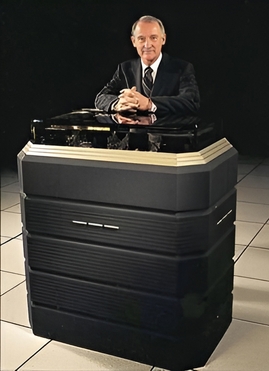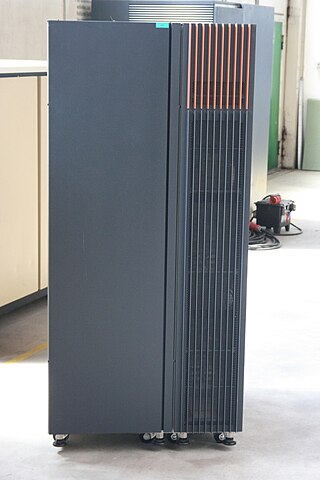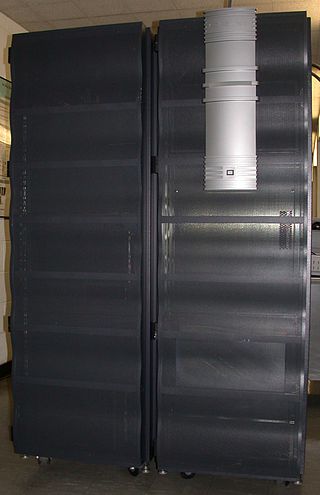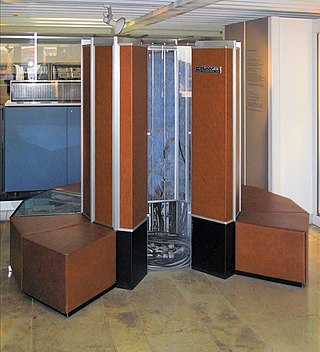Related Research Articles

The Cray-1 was a supercomputer designed, manufactured and marketed by Cray Research. Announced in 1975, the first Cray-1 system was installed at Los Alamos National Laboratory in 1976. Eventually, eighty Cray-1s were sold, making it one of the most successful supercomputers in history. It is perhaps best known for its unique shape, a relatively small C-shaped cabinet with a ring of benches around the outside covering the power supplies and the cooling system.
In computing, a vector processor or array processor is a central processing unit (CPU) that implements an instruction set where its instructions are designed to operate efficiently and effectively on large one-dimensional arrays of data called vectors. This is in contrast to scalar processors, whose instructions operate on single data items only, and in contrast to some of those same scalar processors having additional single instruction, multiple data (SIMD) or SWAR Arithmetic Units. Vector processors can greatly improve performance on certain workloads, notably numerical simulation and similar tasks. Vector processing techniques also operate in video-game console hardware and in graphics accelerators.
The Advanced Scientific Computer (ASC) is a supercomputer designed and manufactured by Texas Instruments (TI) between 1966 and 1973. The ASC's central processing unit (CPU) supported vector processing, a performance-enhancing technique which was key to its high-performance. The ASC, along with the Control Data Corporation STAR-100 supercomputer, were the first computers to feature vector processing. However, this technique's potential was not fully realized by either the ASC or STAR-100 due to an insufficient understanding of the technique; it was the Cray Research Cray-1 supercomputer, announced in 1975 that would fully realize and popularize vector processing. The more successful implementation of vector processing in the Cray-1 would demarcate the ASC as first-generation vector processors, with the Cray-1 belonging in the second.

The Cray X-MP was a supercomputer designed, built and sold by Cray Research. It was announced in 1982 as the "cleaned up" successor to the 1975 Cray-1, and was the world's fastest computer from 1983 to 1985 with a quad-processor system performance of 800 MFLOPS. The principal designer was Steve Chen.
ETA Systems was a supercomputer company spun off from Control Data Corporation (CDC) in the early 1980s in order to regain a footing in the supercomputer business. They successfully delivered the ETA-10, but lost money continually while doing so. CDC management eventually gave up and folded the company.

The ETA10 is a vector supercomputer designed, manufactured, and marketed by ETA Systems, a spin-off division of Control Data Corporation (CDC). The ETA10 was an evolution of the CDC Cyber 205, which can trace its origins back to the CDC STAR-100, one of the first vector supercomputers to be developed.
Alliant Computer Systems Corporation was a computer company that designed and manufactured parallel computing systems. Together with Pyramid Technology and Sequent Computer Systems, Alliant's machines pioneered the symmetric multiprocessing market. One of the more successful companies in the group, over 650 Alliant systems were produced over their lifetime. The company was hit by a series of financial problems and went bankrupt in 1992.

Amdahl Corporation was an information technology company which specialized in IBM mainframe-compatible computer products, some of which were regarded as supercomputers competing with those from Cray Research. Founded in 1970 by Gene Amdahl, a former IBM computer engineer best known as chief architect of System/360, it has been a wholly owned subsidiary of Fujitsu since 1997. The company was located in Sunnyvale, California.

The Cray Y-MP was a supercomputer sold by Cray Research from 1988, and the successor to the company's X-MP. The Y-MP retained software compatibility with the X-MP, but extended the address registers from 24 to 32 bits. High-density VLSI ECL technology was used and a new liquid-cooling system was devised. The Y-MP ran the Cray UNICOS operating system.

The CDC STAR-100 is a vector supercomputer that was designed, manufactured, and marketed by Control Data Corporation (CDC). It was one of the first machines to use a vector processor to improve performance on appropriate scientific applications. It was also the first supercomputer to use integrated circuits and the first to be equipped with one million words of computer memory.

The Cray-3 was a vector supercomputer, Seymour Cray's designated successor to the Cray-2. The system was one of the first major applications of gallium arsenide (GaAs) semiconductors in computing, using hundreds of custom built ICs packed into a 1 cubic foot (0.028 m3) CPU. The design goal was performance around 16 GFLOPS, about 12 times that of the Cray-2.

The SX-6 is a NEC SX supercomputer built by NEC Corporation that debuted in 2001; the SX-6 was sold under license by Cray Inc. in the U.S. Each SX-6 single-node system contains up to eight vector processors, which share up to 64 GB of computer memory. The SX-6 processor is a single chip implementation containing a vector processor unit and a scalar processor fabricated in a 0.15 μm CMOS process with copper interconnects, whereas the SX-5 was a multi-chip implementation. The Earth Simulator is based on the SX-6 architecture.
The Fujitsu FACOM VP is a series of vector supercomputers designed, manufactured, and marketed by Fujitsu. Announced in July 1982, the FACOM VP were the first of the three initial Japanese commercial supercomputers, followed by the Hitachi HITAC S-810 in August 1982 and the NEC SX-2 in April 1983.

The SX-8 is a supercomputer built by NEC Corporation. The SX-8 Series implements an eight-way SMP system in a compact node module and uses an enhanced version of the single chip vector processor that was introduced with the SX-6. The NEC SX-8 processors run at 2 GHz for vectors and 1 GHz for scalar operations. The SX-8 CPU operates at 16 GFLOPS and can address up to 128 GB of memory. Up to 8 CPUs may be used in a single node, and a complete system may have up to 512 nodes. The SX-8 series ranges from the single-CPU SX-8b system to the SX-8/4096M512, with 512 nodes, 4,096 CPUs, and a peak performance of 65 TFLOPS. There is up to 512 GB/s bandwidth per node. The SX-8 runs SUPER-UX, a Unix-like operating system developed by NEC.

The Cray T90 series was the last of a line of vector processing supercomputers manufactured by Cray Research, Inc, superseding the Cray C90 series. The first machines were shipped in 1995, and featured a 2.2 ns (450 MHz) clock cycle and two-wide vector pipes, for a peak speed of 1.8 gigaflops per processor; the high clock speed arises from the CPUs being built using ECL logic. As with the Cray J90, each CPU contained a scalar data cache, in addition to the instruction buffering/caching which has always been in Cray architectures.

The Cray J90 series was an air-cooled vector processor supercomputer first sold by Cray Research in 1994. The J90 evolved from the Cray Y-MP EL minisupercomputer, and is compatible with Y-MP software, running the same UNICOS operating system. The J90 supported up to 32 CMOS processors with a 10 ns clock. It supported up to 4 GB of main memory and up to 48 GB/s of memory bandwidth, giving it considerably less performance than the contemporary Cray T90, but making it a strong competitor to other technical computers in its price range. All input/output in a J90 system was handled by an IOS called IOS Model V. The IOS-V was based on the VME64 bus and SPARC I/O processors (IOPs) running the VxWorks RTOS. The IOS was programmed to emulate the IOS Model E, used in the larger Cray Y-MP systems, in order to minimize changes in the UNICOS operating system. By using standard VME boards, a wide variety of commodity peripherals could be used.
The SPARC64 V (Zeus) is a SPARC V9 microprocessor designed by Fujitsu. The SPARC64 V was the basis for a series of successive processors designed for servers, and later, supercomputers.
The HITAC S-810 is a family of vector supercomputers developed, manufactured and marketed by Hitachi. The S-810, first announced in August 1982, was the second Japanese supercomputer, following the Fujitsu VP-200 but predating the NEC SX-2. The S-810 was Hitachi's first supercomputer, although the company had previously built a vector processor, the IAP.

The term supercomputing arose in the late 1920s in the United States in response to the IBM tabulators at Columbia University. The CDC 6600, released in 1964, is sometimes considered the first supercomputer. However, some earlier computers were considered supercomputers for their day such as the 1954 IBM NORC in the 1950s, and in the early 1960s, the UNIVAC LARC (1960), the IBM 7030 Stretch (1962), and the Manchester Atlas (1962), all of which were of comparable power.
FACOM is a trademark used for Fujitsu's computers. The first product is FACOM 100, built in 1954. In May 1990, the brand name of FACOM was abolished and changed to Fujitsu.
References
- ↑ "Historical Computers in Japan: Fujitsu VP2000 Series". Information Processing Society of Japan Computer Museum. 2015. Archived from the original on 3 July 2015. Retrieved 11 October 2015.
- ↑ Dongarra, Jack (2007). "Frequently Asked Questions on the Linpack Benchmark and Top500". Netlib. Archived from the original on 1 September 2009. Retrieved 14 January 2014.
